There are 3 ways that Heat is Transferred
- Convective Heat Transfer
- Radiant Heat Transfer
- Direct Heat Transfer
The Therma Vent system addresses all three ways that Heat is transfer by Releasing the Convective heat, Reflecting the Radiant heat, and stopping the direct heat. This is the only Ventilation system in American that addresses all 3 ways heat is transferred effectively. In this article we will first go into detail the 3 ways that heat is transferred and then describe and show how the Therma Vent system deals with all 3 ways heat is transferred with remarkable results. Tests have been completed actual houses that have had the Therma Vent system installed and tests have also been done on models that we have results for.
- Convective Heat Transfer
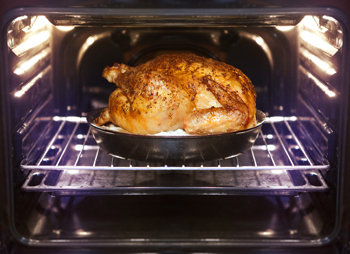 Think of a turkey in an oven, where the heating element is turned on and heats the air inside the oven, and then it is the hot air that cooks the turkey. When the oven door is opened it would release the hot air and would not be able to cook the turkey. Imagine if a door was installed at the bottom of the oven and opened. There would not be any way to cook anything in that oven because now as the air is heated up it will rise and then it would bring
Think of a turkey in an oven, where the heating element is turned on and heats the air inside the oven, and then it is the hot air that cooks the turkey. When the oven door is opened it would release the hot air and would not be able to cook the turkey. Imagine if a door was installed at the bottom of the oven and opened. There would not be any way to cook anything in that oven because now as the air is heated up it will rise and then it would bring 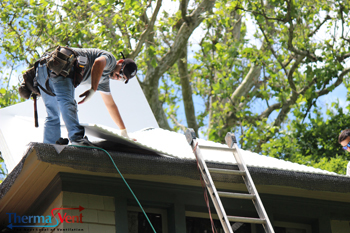 in fresh air that is cooler from the bottom over door. This is exactly how the Therma Vent system deals with convective heat, we open the over door and release all the hot air in your attic and roof. Vents would be install just like the over door concept to allow air to come into your attic and under your roof at the base, while also making sure the main oven door at the ridge of your roof is opened allowing for all the hot air to be released thus bringing in new fresh air at the eaves which is located at the bottom of your attic and roof.
in fresh air that is cooler from the bottom over door. This is exactly how the Therma Vent system deals with convective heat, we open the over door and release all the hot air in your attic and roof. Vents would be install just like the over door concept to allow air to come into your attic and under your roof at the base, while also making sure the main oven door at the ridge of your roof is opened allowing for all the hot air to be released thus bringing in new fresh air at the eaves which is located at the bottom of your attic and roof.
- Radiant Heat Transfer
This is the hardest heat transfer to describe without sounding like PHD talk. Radiant heat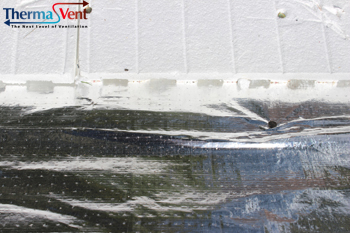 transfer is the only way that heat can be transferred without a medium. Convective and direct heat transfer needs a source, some way to transfer the heat; Radiant heat does not need a source to transfer the heat. Radiant heat moves in random directions which makes it harder to combat. When Radiant heat comes in contact with another surface it can either be transmitted through, absorbed into, or reflected away from.
transfer is the only way that heat can be transferred without a medium. Convective and direct heat transfer needs a source, some way to transfer the heat; Radiant heat does not need a source to transfer the heat. Radiant heat moves in random directions which makes it harder to combat. When Radiant heat comes in contact with another surface it can either be transmitted through, absorbed into, or reflected away from.
Think about your car sitting in the sun on a hot summer day, if you leave you windows up the Radiant waves of the sun will hit your windshield and some of the radiant heat will be absorbed into the glass of the windshield, but a lot  of the radiant heat will be transmitted right into your car and heat your car up. They say always put a thermometer in the shade to get a proper reading, but have you ever wondered why the same does not apply to inside your car when it’s in direct sun. Why would your car roof, window, and windshield not act as a barrier for shade and stay the same as the outside air temperature. Radiant heat is a big factor that is why the inside of your car can reach temperatures of over 150 degrees just like your attic, there is nothing to reflect the radiant heat away, and in fact the surfaces on your car like metal and glass will absorb and transmit the radiant heat and will not reflect it. Have you ever used the shades that
of the radiant heat will be transmitted right into your car and heat your car up. They say always put a thermometer in the shade to get a proper reading, but have you ever wondered why the same does not apply to inside your car when it’s in direct sun. Why would your car roof, window, and windshield not act as a barrier for shade and stay the same as the outside air temperature. Radiant heat is a big factor that is why the inside of your car can reach temperatures of over 150 degrees just like your attic, there is nothing to reflect the radiant heat away, and in fact the surfaces on your car like metal and glass will absorb and transmit the radiant heat and will not reflect it. Have you ever used the shades that 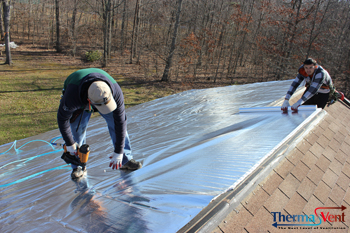 are sold for your car’s windshield? Most of the time those shades have a silver reflective surface on them that will reflect the radiant heat. That is called a radiant barrier, and it will only work if there is an air gap on one side or the other. When it’s on the dash of your car behind your windshield it will have an air gap on both sides allowing the reflectivity to bounce the radiant waves back away from your car and back through your windshield. The Therma Vent system has the same concept of reflecting the radiant heat. The air gaps in the channels allow for the radiant waves to be reflected back away from your attic before it even gets into your attic. This is a huge reason we are able to change attic temperatures of 150 degree down to 103 degrees.
are sold for your car’s windshield? Most of the time those shades have a silver reflective surface on them that will reflect the radiant heat. That is called a radiant barrier, and it will only work if there is an air gap on one side or the other. When it’s on the dash of your car behind your windshield it will have an air gap on both sides allowing the reflectivity to bounce the radiant waves back away from your car and back through your windshield. The Therma Vent system has the same concept of reflecting the radiant heat. The air gaps in the channels allow for the radiant waves to be reflected back away from your attic before it even gets into your attic. This is a huge reason we are able to change attic temperatures of 150 degree down to 103 degrees.
- Direct Heat Transfer
 Do you drink hot coffee or hot tea? Have you ever wondered why a paper coffee cup without a sleeve on it will burn you hand due to the heat coming from the coffee, while hot coffee in a Styrofoam cup won’t even make your hand sweat. What’s the difference? The difference is not the heat of the coffee right, it’s the same hot coffee in both cups. Paper cups transfer the direct heat extraordinarily well, while foam does not allow for the direct heat to transfer through to your hand. The thickness of a foam coffee cup is only about 1/8 of an inch, but it is able to stop the heat of over 180 degrees from transferring through to your hand. Whereas, the paper cup with coffee that is 180 degrees you will either burn your hand or drop your coffee because it is so
Do you drink hot coffee or hot tea? Have you ever wondered why a paper coffee cup without a sleeve on it will burn you hand due to the heat coming from the coffee, while hot coffee in a Styrofoam cup won’t even make your hand sweat. What’s the difference? The difference is not the heat of the coffee right, it’s the same hot coffee in both cups. Paper cups transfer the direct heat extraordinarily well, while foam does not allow for the direct heat to transfer through to your hand. The thickness of a foam coffee cup is only about 1/8 of an inch, but it is able to stop the heat of over 180 degrees from transferring through to your hand. Whereas, the paper cup with coffee that is 180 degrees you will either burn your hand or drop your coffee because it is so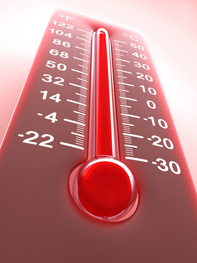 hot. Now think about your roof, if you have 170 degree asphalt shingles or metal sitting on your plywood deck will that transfer through into your attic. The answer is yes most of it will, because we are getting readings over 150 degrees in attic on a 90 degree day, and the temperature of the shingles is over 170 degrees. So Plywood or OSB decking is a great transference of heat. Now think about the coffee, if 1/8 of one inch of foam would stop 180 degrees of heat from going through to your hand what you think 6/8 of an inch of foam would do to 170 degree asphalt shingle roof? It is one of the best mediums for stopping direct head heat from going through into your attic, and what does goes through is vented out by way of the hot air rising through the channels that allows the convective heat to be released.
hot. Now think about your roof, if you have 170 degree asphalt shingles or metal sitting on your plywood deck will that transfer through into your attic. The answer is yes most of it will, because we are getting readings over 150 degrees in attic on a 90 degree day, and the temperature of the shingles is over 170 degrees. So Plywood or OSB decking is a great transference of heat. Now think about the coffee, if 1/8 of one inch of foam would stop 180 degrees of heat from going through to your hand what you think 6/8 of an inch of foam would do to 170 degree asphalt shingle roof? It is one of the best mediums for stopping direct head heat from going through into your attic, and what does goes through is vented out by way of the hot air rising through the channels that allows the convective heat to be released.
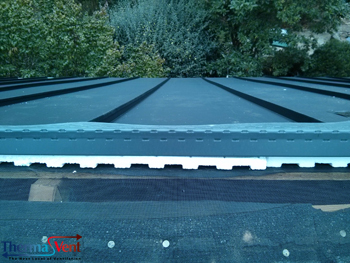 The Therma Vent is so effective that our tests between a Black Asphalt Shingles roof with the Therma Vent installed compared to a Metal roof with the Therma Vent installed that also has an energy star matte paint that reflects the heat, we found through testing that the Asphalt Shingle roof has a cooler temperature of 2 degrees less on average than the Metal roof. Never by any tests have we ever seen has a Black Asphalt roof ever beaten out an energy star metal roof. This shows how effective the Therma Vent system is at Releasing the Convective Heat, Reflecting the Radiant Heat, and Stopping the Direct Heat.
The Therma Vent is so effective that our tests between a Black Asphalt Shingles roof with the Therma Vent installed compared to a Metal roof with the Therma Vent installed that also has an energy star matte paint that reflects the heat, we found through testing that the Asphalt Shingle roof has a cooler temperature of 2 degrees less on average than the Metal roof. Never by any tests have we ever seen has a Black Asphalt roof ever beaten out an energy star metal roof. This shows how effective the Therma Vent system is at Releasing the Convective Heat, Reflecting the Radiant Heat, and Stopping the Direct Heat.